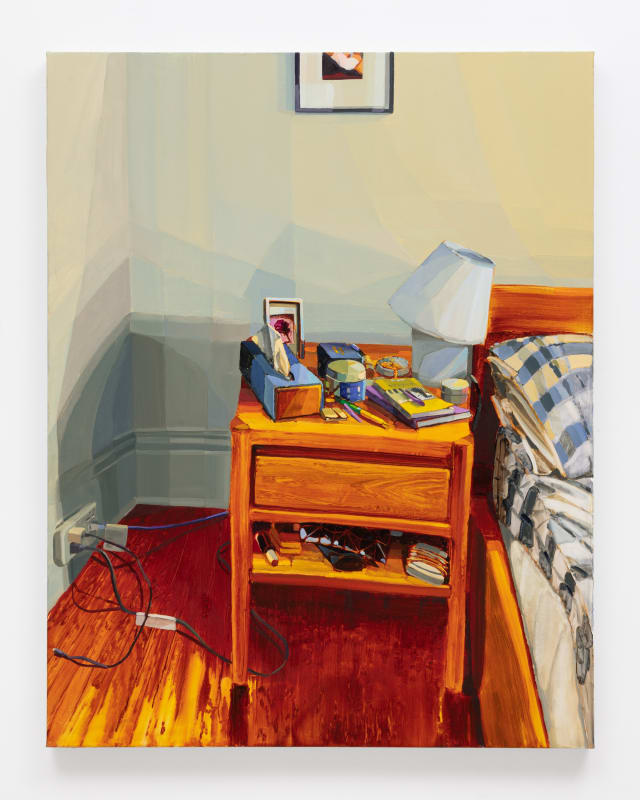The subjects of Keiran Brennan Hinton’s paintings are straightforward. He depicts the world around him, portraying nothing more than what he is able to observe. His domestic scenes are relatively ordinary, adorned with personal items—nothing scandalous, overly symbolic, or too revealing of the owner’s character—in simple interiors that are not mundane, yet not quite distinctive. His views of forests and lakes are beautiful, but then again, many such features of the natural world are beautiful. Taken at face value, Brennan Hinton’s content is in a Goldilocks Zone: not boring, not exciting, but rather, firmly pleasant.
However, face value isn’t what the artist is interested in. For Brennan Hinton’s latest solo show, A Break in the Clouds at Charles Moffett, he presents various personal settings that are ambiguous enough to invite the viewer in. Mainly large-scale, the works on view (all 2023) are in the tradition of interior and plein air painting, but push against the standard, quickly rendered characteristic of the latter, instead capturing the same subject over many hours or days to focus on the prolonged act of viewing and the passage of time. Perhaps best seen in Midsummer Forest, dappled light and shadow blanket the composition, as if a vibrant sun constantly streams through the branches and leaves. Yet there is no sun in the work at all. Instead, the tangled array of shadows attests to its journey across the sky.
In A Week in March, Brennan Hinton has painted a view of a domestic interior. Incongruous light and shadows streaming along the floor and walls again suggest the passage of time. Distinct ceiling beams angle toward the viewer as if they have spun in circles and stopped abruptly, focusing on a vertical post in the center as the rest of the room falls toward the back, resulting in a beguiling, convex perspective. The image provides far more information than a singular point frozen in time could reveal. Even the reflective surfaces, like the pots hanging in the kitchen and the refrigerator door, bear evidence of different lights, from glowing yellows to warm pinks and purples.
Few figures appear. When they are visible, Brennan Hinton has only provided suggestions of bodies, like the abstract basketball players running across a TV screen. Instead, he implies human presence in small details, such as the steam emanating from a mug in Morning Coffee and the tilt of a lamp knocked askew in Bedside Table. While human life is absent, each scene retains a sense of energy from the light itself as it blankets the walls, furniture, and contents of the rooms, moving from spot to spot throughout the day.
To create some of his work, Brennan Hinton also moved the canvas itself. Giving the viewer glimpses of what is visible beyond the edges of a single point of view, the artist angled his body and shifted his easel to combine multiple perspectives—perhaps explaining the disorienting vantage point in A Week in March. He also rejected traditional hierarchies of foreground and background, at times prioritizing both. In Beecher Lane, a dramatic foreground pulls the viewer up the driveway toward the fertile lawn and houses. In the background, much of the sky is blue with a few puffs of clouds and a gray patch in the distance. Heavy drops of rain scatter across the surface in distinct, vertical dashes. Combining multiple weather conditions into one work, Brennan Hinton captures a snapshot of the climate’s potential. Indeed, weather itself seems to be the main character of the piece, as if the landscape and homes just happen to be there.
The same can be said of a table depicted in several paintings. A conspicuous piece of furniture with its highly reflective surface, the object is best seen in Morning Coffee and Tiger Lilies. Comprising nearly half of both compositions, the table seems to be a tool through which to see the rich foliage and sky outside the window. The green exterior bathed in bright light contrasts the dim interior in Tiger Lilies, perhaps an amalgamation of several moments of warm sunshine. In Morning Coffee, the artist takes a more prolonged approach to capturing the changes in atmosphere throughout the day, reflected in yellow, blue, purple, and pink hues on the windowsill, lampshade, and surface of the table. Despite its size and the prominent attention given in the compositions, the table is overshadowed by the image it serves to reflect.
The ordinary quality of Brennan Hinton’s subject matter is what makes his work so spectacular. He isn’t interested in shock value or superfluous details; rather he homes in on the things that make something commonplace remarkable, what makes an average day beautiful. He focuses on the nuances of changing light, the brilliance of a sunbeam, the downward motion of a heavy raindrop, and the extraordinary contrast of light and shadow. His paintings may depict a forest or a room of his house, but these are not the subjects. Rather, his subjects are the things that are ephemeral, difficult to see, or perhaps only visible over the course of many hours. They are the glimpses of the indefinable aspects that fill any room or any forest. Beauty can exist in even the most ordinary of settings, it just might take a closer look to see.
Keiran Brennan Hinton
Annabel Keenan, The Brooklyn Rail, 1 October 2023


